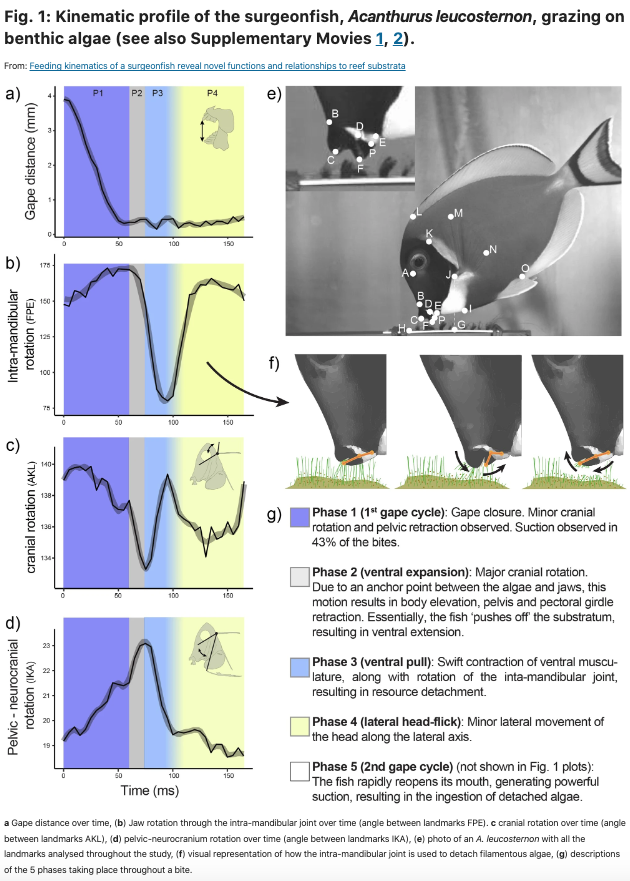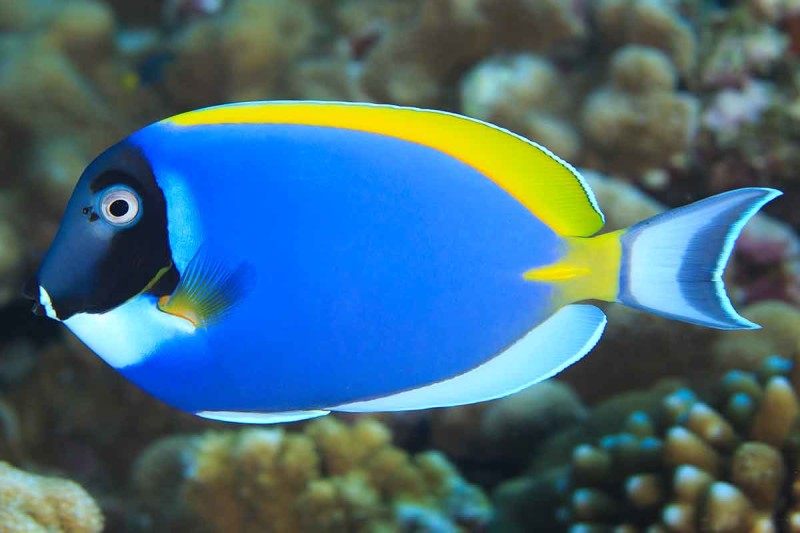Researchers have used high-speed video to study the feeding mechanisms of the Powder Blue Tang, Acanthurus leucosternon. Reef fish use feeding modes including high-speed suction and biting, the former method proving key to the explosive success of ray-finned fishes. But feeding via biting benthic prey (like algae on rocks,) has proved another important strategy, resulting in the co-evolution of both coral reefs and reef fish.
Coral reefs need herbivores to keep algae turfs in check, which would otherwise smother corals. But just like grass grazing mammals on the Serengeti, different fish species graze algae in different ways, using different techniques, and expending differing amounts of energy to do so. Surgeonfish are key to healthy coral reefs, yet little is known about how they feed and their mechanisms to remove the algae from the rocks.
Two species of Zebrasoma have been studied before though, where Perevolotsky, et al. discovered that they use their entire body and fins to detach prey from benthic substrates through the use of a lateral head-flick. Think about your own Zebrasoma species when grazing and that head flick is right.
But when Michalis Mihalitsis and Peter Wainwright of the Department of Evolution and Ecology, at the University of California used camera technology to slow down the grazing of Powder Blue tangs (Acanthurus,) the Zebrasoma style head flick was absent, the Powder blue using a different technique instead.
“After gripping algae in its jaws, the species pulls it by ventrally rotating both the head and the closed jaws, in a novel use of the intra-mandibular joint,” the researchers said in a paper published this year in the journal Communications Biology. “These motions remain in the plane of the fish, reducing the use of a lateral head flick to detach the algae. The novel ability to bite and pull algae off the substrate without bending the body laterally minimizes exposure to high water flows and may be an adaptation to feeding in challenging reef habitats such as the crest and flat. Therefore, our results could potentially represent a key milestone in the evolutionary history of coral reef trophodynamics.”
In diverse natural habitats, large numbers of species only exist by becoming specialists, and that often means being able to do one or more things differently or better than your neighbors. In freshwater Lake Malawi with cichlids, the Rio Xingu with plecos, and coral reefs with surgeonfish, the ability to access the algae in the highest flow areas, and do it for the least energy is what sets species apart. In the case of the Powder Blue Tang, and maybe other Acanthurus species, it seems that being able to feed without flicking the head enables them to hold position in high-flow while grazing, giving them the advantage over other surgeonfish genera in that habitat.

For more information, and to read the full scientific paper, go to:
Mihalitsis, M., Wainwright, P.C. Feeding kinematics of a surgeonfish reveal novel functions and relationships to reef substrata. Commun Biol 7, 13 (2024). https://doi.org/10.1038/s42003-023-05696-z



